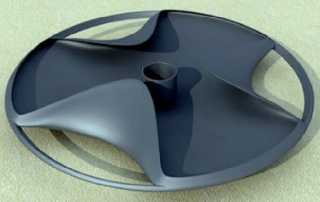|
 |
Subclick <no### [at] sp am> wrote:
> If I understand its purpose correctly, the I_Phi function should be
> #declare I_Phi = function {atan2(z, x)}
Yeah - I often try to do this stuff while juggling 3 other things, 2
conversations, and a 10 yo playing/commenting on video games right next to me.
I had the same feeling but not enough conviction at the time to make the change.
> F_Wave should probably converge to a constant (the amplitude of the wave
> vanishing) as (x, 0, z) approaches the origin, rather than continue to
> oscillate with a fixed amplitude along an ever tinier circumference,
> which produces an unbounded gradient.
Yep, that's likely the insight I was missing.
> For example,
> #declare F_Wave = function
> {0.8*sqrt(pow(x,2)+pow(z,2))*sin(3*I_Phi(x, 0, z))}
> You’ll probably want more than three ridges, however.
>
> Note your I function has an infinite gradient on the y = F_Wave(x, y, z)
> surface. You could instead do something like
> #declare F_Cap = function
> {pow(x,2)+pow(max(y,0),2)+pow(z,2) - pow(ISphereR,2)}
> #declare S_Wave = function {F_Cap(x, y - F_Wave(x, y, z), z)}
> The 0.8 factor in F_Wave may need tweaking.
>
> Now you need to cut off with an intersection or differencethe part of
> the isosurface below the y = 0 plane, adjust the “contained_by” object
> and put the result in a union or merge with half a sphere object, which
> I think will be faster to render than retaining the lower hemisphere as
> part of the isosurface.
Lots to digest and experiment and learn from, as always.
As complex as the present form may seem, it's still just an overly simplified
model. What I'm shooting for is attached, and I really don't want to do it as
CSG, because the elegant form just SCREAMS "minimal surface" or "algebraic
surface". It has curves and round transitions, and circular arcs and parabolas
that all just _flow_.
Thank you for your excellent help and suggestions - it will certainly help
reorient my thoughts in pursuing this challenging project. am> wrote:
> If I understand its purpose correctly, the I_Phi function should be
> #declare I_Phi = function {atan2(z, x)}
Yeah - I often try to do this stuff while juggling 3 other things, 2
conversations, and a 10 yo playing/commenting on video games right next to me.
I had the same feeling but not enough conviction at the time to make the change.
> F_Wave should probably converge to a constant (the amplitude of the wave
> vanishing) as (x, 0, z) approaches the origin, rather than continue to
> oscillate with a fixed amplitude along an ever tinier circumference,
> which produces an unbounded gradient.
Yep, that's likely the insight I was missing.
> For example,
> #declare F_Wave = function
> {0.8*sqrt(pow(x,2)+pow(z,2))*sin(3*I_Phi(x, 0, z))}
> You’ll probably want more than three ridges, however.
>
> Note your I function has an infinite gradient on the y = F_Wave(x, y, z)
> surface. You could instead do something like
> #declare F_Cap = function
> {pow(x,2)+pow(max(y,0),2)+pow(z,2) - pow(ISphereR,2)}
> #declare S_Wave = function {F_Cap(x, y - F_Wave(x, y, z), z)}
> The 0.8 factor in F_Wave may need tweaking.
>
> Now you need to cut off with an intersection or differencethe part of
> the isosurface below the y = 0 plane, adjust the “contained_by” object
> and put the result in a union or merge with half a sphere object, which
> I think will be faster to render than retaining the lower hemisphere as
> part of the isosurface.
Lots to digest and experiment and learn from, as always.
As complex as the present form may seem, it's still just an overly simplified
model. What I'm shooting for is attached, and I really don't want to do it as
CSG, because the elegant form just SCREAMS "minimal surface" or "algebraic
surface". It has curves and round transitions, and circular arcs and parabolas
that all just _flow_.
Thank you for your excellent help and suggestions - it will certainly help
reorient my thoughts in pursuing this challenging project.
Post a reply to this message
Attachments:
Download 'disk.png' (241 KB)
Preview of image 'disk.png'

|
 |




![]()